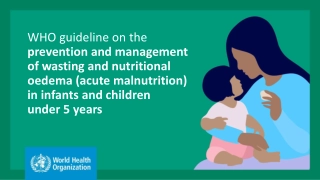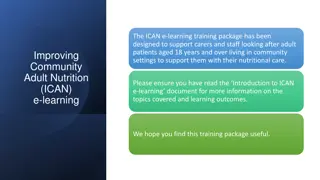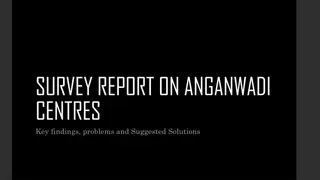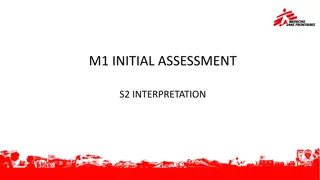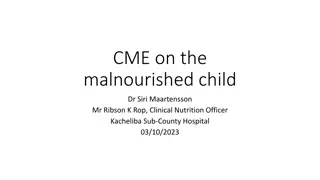Role of Anganwadi Workers in Combating Child Malnutrition in India
Anganwadi workers play a crucial role in addressing child malnutrition, infant mortality, and lack of education in India. They operate under the Integrated Child Development Services (ICDS) scheme, providing essential healthcare, nutrition, and educational support to children aged 0-6 years. With a network of over a million centers and female workers, Anganwadi workers are frontline caregivers working towards improving the health and well-being of marginalized communities.
Download Presentation

Please find below an Image/Link to download the presentation.
The content on the website is provided AS IS for your information and personal use only. It may not be sold, licensed, or shared on other websites without obtaining consent from the author. Download presentation by click this link. If you encounter any issues during the download, it is possible that the publisher has removed the file from their server.
E N D
Presentation Transcript
INTRODUCTION Anganwadi mean(an central area in and around the house where most of the social activities of the household takes place). Anganwadi is a government sponsored child-care and mother-care center in India. It caters to children in the 0-6 age group. The word means "courtyard shelter" in Hindi.
India is home to the largest population of malnourished and hunger-stricken people and children leading to high infant and maternal mortality. Problems ranging from diseases, lack of education, lack of hygiene, illness, etc are cause for malnutrition. To combat this situation, the Government of India in 1975 initiated the Integrated Child Development Service (ICDS) scheme which operates at the state level to address the health issues of small children, all over the country.
ICDS (1975) Started by the Indian Government in 1975 as the part of ICDS programme to combat child hunger and malnutrition. It is one of the largest child care programmes in the world aiming at child health, hunger, mal nutrition and its related issues Under the ICDS scheme, one trained person is allotted to a population of 1000, to bridge the gap between the person and organized healthcare, and to focus on the health and educational needs of children aged 0-6 years. This person is the Anganwadi worker.
Anganwadi workers are Indias primary tool against the menace of child malnourishment, infant mortality, and lack of child education, community health problems and in curbing preventable diseases. They provide services to villagers, poor families and sick people across the country helping them access healthcare services, immunization, healthy food, hygiene, and provide healthy learning environment for infants, toddlers and children.
SYSTEM OF WORKERS The Anganwadi system is mainly managed by the Anganwadi worker. She is a health worker chosen from the community and given 4 months training in health, nutrition and child- care. She is incharge of an Anganwadi which covers a population of 1000. She paid 200-250 per month. 20 to 25 Anganwadi workers are supervised by a Supervisor called Mukhyasevika.
4 Mukhyasevikas are headed by a Child Development Projects Officer (CDPO). There are an estimated 1.053 million anganwadi centers employing 1.8 million mostly-female workers and helpers across the country.
ROLE OF ANGANWADI WORKER They provide outreach services to poor families in need of immunization, healthy food, clean water, clean toilets and a learning environment for infants, toddlers and pre- schoolers. They also provide similar services for expectant and nursing mothers. According to government figures, anganwadi's reach about 58.1 million children and 10.23 million pregnant or lactating women.
REFERENCE Park. K, 2015, Park s Textbook of Preventive and Social Medicine.


